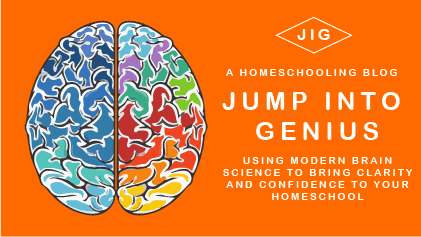We all know kids are different. Yet we all have brains made out of the same stuff. So do the differences in our kids mean we should teach them differently? This is how learning style is usually presented. If your kids remembers pictures better than things he hears, then you should teach just with pictures. Likewise, if your child is kinesthetic, you should incorporate physical movement into everything you teach. I always thought this did not make complete sense. I felt it only made sense to use all of these modes of learning with every child. After all, don’t they need practice using their brains in different ways, even if that is not always their preferred way?
(You are reading the seventh post in a series about cognitive science in your homeschool, click here for the introductory post and links to the other posts in this series.)
After reading Willingham’s chapter on learning styles, I finially understand why I felt this way, why I was right, and also what piece of the puzzle I was still missing. Although the theory of teaching to learning styles is popular, after 50 years of research scientists have not been able to confirm any advantages gained by teaching a child in their preferred style.
Children are more alike than different in terms of how they learn. Willingham
First, let’s sort out the difference between cognitive ability and cognitive style. Cognitive ability means you either can or do have success in certain types of thought. If someone has a lot of ability they can learn quickly and pick up new skills and facts with relative ease. A cognitive style is independent of ability, it is a preferred way of thinking. For example, one might claim they prefer to think about everything sequentially and another might prefer to think holistically.
More ability is better than less ability. But one style is not better than another style. Although sometimes certain problems are much more easily solved with a certain style of thought, they are overall, all equally useful. One thing researchers have to be careful of when designing studies to uncover cognitive styles, is to make sure they are not inadvertently measuring ability.
A cognitive styles theory would need to do the following three things. The person must consistently be shown to have the same cognitive style, it cannot change based on what content is being used in the test. It would need to show that people with different styles think and learn differently. Finally, it would need to show that people with different styles do not differ in ability. So far, no cognitive theories that have been tested have been able to meet these criteria. That does not mean there are no cognitive styles, but considering the amount of research that has been done in this area, it does not currently look promising.
The most popular cognitive style theory is the visual, auditory, kinesthetic learners theory I mentioned above. A popular, widespread theory, which has no scientific research which actually shows that teaching to your kid’s preferred style helps them learn better. So why is it popular? Willingham suggests one reason is that it is not far from some truths. We all know some kids remember pictures well and others remember what they hear. “People do differ in their visual and auditory memory abilities.” (Willingham) The main reason these differences do not carry over into learning is that we are seldom memorizing pictures or sounds. If we need to learn the meaning, storing information as sound or sight, does not work. When students with a good visual memory were given vocabulary with pictures vs. without pictures, they did not remember the vocabulary that was represented with pictures better than the vocabulary that was not. Why? Because they did not need to remember the picture, they needed to remember the meaning of the word.
If someone tells you a funny story do you remember what they looked like and sounded like, or do you remember the story?
“Meaning has a life of its own, independent of sensory details.” Willingham
Yes, some kids have great visual memories, some kids have great auditory memory. However, the prediction of the theory, that they will learn better if taught in their preferred modality is not supported by the research.
In Your Homeschool
When teaching your child “craft knowledge trumps science” (Willingham), this means keep your eye out for what helps your kid understand ideas and meaning and go with that. The scientists have nothing solid to offer as to how we can actually use our kid’s differences to help them learn better.
Learning styles do not help much when applied to students, but they can help when applied to content. Certain content should be seen, such as a map. Other content should be heard, like poetry.
Another way using all three modalities helps is because change helps attention. Switching modes of sensory input will keep your kids focused for longer.
This is just a short explanation of the concept covered by Willingham. There is so much more in his book, and I strongly recommend reading it. One thing Willingham does in his book is take you through many more examples, persuading you as he introduces each idea. If I had a top ten books home educators should read, this would be on it.



2 Responses
[…] Read this for more about why learning styles don’t matter as much as we have been led to believe. […]
[…] What About Learning Styles? […]